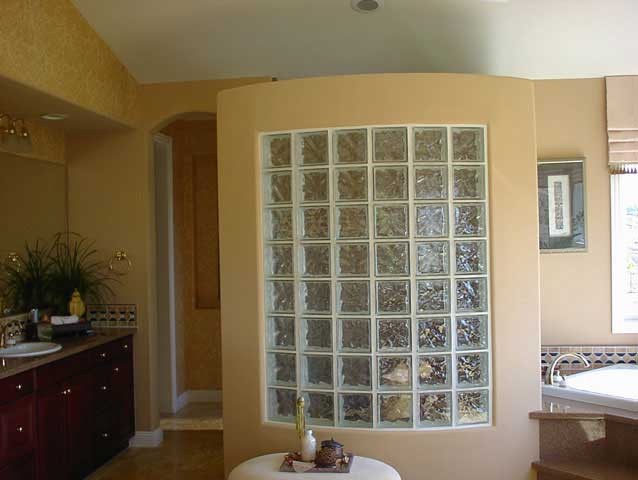Glass block wall
Glass blocks, or bricks, can be used to create architectural structures such as partition walls or screen walls across part of a room, around a shower or bath, as part of stair constructions and so on. They are capable of dividing a room without blocking light transmission.
Glass block walls are not generally load-bearing, and may need to be strengthened by steel reinforcing rods positioned in the mortar, or by the framing into which they are set. The reason they are not generally load-bearing is that, typically, glass blocks are manufactured hollow, i.e. they are two separate halves which are pressed together and annealed while still molten, leaving a partial vacuum at the centre.
Blocks are produced in various square and rectangular sizes (typically 4 x 8”, 6 x 8” and 8 x 8”), as well as in angled and curved shapes.
Since glass blocks cannot be cut to bespoke sizes, it is important to calculate how the standard sizes fit best into the space required. To roughly calculate the number of blocks required, the length of the wall can be multiplied by its height to find the overall area, before dividing this by the area of one glass block. This calculation does not allow for the mortar joints, and it is recommended to over-purchase in case blocks break during installation.
The first step in laying a glass block wall or screen is to lay out a single row of blocks to work out its general positioning, and the location of any openings (such as doors). If using a timber frame, this should be made to fit the chosen wall dimensions and fixed in place. Expansion foam is then nailed to the inside of the frame, which permits small amounts of movement due to thermal expansion. The foam should be positioned to sit centrally on each length of timber.
Spacers should be positioned inside the floor of the timber frame to hold the glass blocks. Mortar is then applied to the floor of the frame, between the spacers. After spreading mortar on one side of a glass block it is then placed onto the spacers, bedding it into the mortar along the frame. Once the full length of blocks has been laid, mortar is applied along the top.
Reinforcing rods are applied to the horizontal joints (two per row of blocks), by drilling holes in the wall plate. For extra rigidity, rods can be applied to the vertical joints as well. The rods should be pressed down into the mortar before continuing laying blocks on top. After every two courses, a wall tie should be screwed to the wall plate and bedded in mortar.
To avoid wall collapse, no more than six courses of blocks should be built before allowing the mortar to dry overnight. Care should be taken while laying that the blocks are level and plumb.
Once the mortar has dried, the joints can be grouted. If the wall is located somewhere it is likely to come into contact with moisture (e.g. a shower screen), silicone sealant should be applied around the perimeter to make the joints waterproof.
A difficulty that can be faced when building up a glass block wall one-by-one, is that they can ‘swim’ (move slightly) as they are placed. A method that can alleviate this is by installing a prefabricated glass block wall - a wall section pre-made into assemblies. Grooves in the top of the bottom section allow the section above to fit securely.
[edit] Related articles on Designing Buildings Wiki
Featured articles and news
The UK's Modern Industrial Strategy: A 10 year plan
Previous consultation criticism, current key elements and general support with some persisting reservations.
Building Safety Regulator reforms
New roles, new staff and a new fast track service pave the way for a single construction regulator.
Architectural Technologist CPDs and Communications
CIAT CPD… and how you can do it!
Cooling centres and cool spaces
Managing extreme heat in cities by directing the public to places for heat stress relief and water sources.
Winter gardens: A brief history and warm variations
Extending the season with glass in different forms and terms.
Restoring Great Yarmouth's Winter Gardens
Transforming one of the least sustainable constructions imaginable.
Construction Skills Mission Board launch sector drive
Newly formed government and industry collaboration set strategy for recruiting an additional 100,000 construction workers a year.
New Architects Code comes into effect in September 2025
ARB Architects Code of Conduct and Practice available with ongoing consultation regarding guidance.
Welsh Skills Body (Medr) launches ambitious plan
The new skills body brings together funding and regulation of tertiary education and research for the devolved nation.
Paul Gandy FCIOB announced as next CIOB President
Former Tilbury Douglas CEO takes helm.
UK Infrastructure: A 10 Year Strategy. In brief with reactions
With the National Infrastructure and Service Transformation Authority (NISTA).
Ebenezer Howard: inventor of the garden city. Book review.
The Grenfell Tower fire, eight years on
A time to pause and reflect as Dubai tower block fire reported just before anniversary.
Airtightness Topic Guide BSRIA TG 27/2025
Explaining the basics of airtightness, what it is, why it's important, when it's required and how it's carried out.
Construction contract awards hit lowest point of 2025
Plummeting for second consecutive month, intensifying concerns for housing and infrastructure goals.
Understanding Mental Health in the Built Environment 2025
Examining the state of mental health in construction, shedding light on levels of stress, anxiety and depression.























Comments